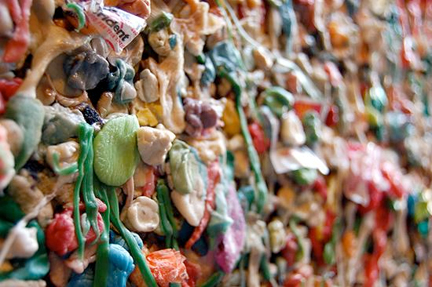 If you travel to Seattle, Washington, you might want to
visit the gum wall under Pike Place Market in the downtown district. You find
the 50’ long sticky brick wall in Post Alley near the Market Theater. In the
1990s, some patrons of the theater were waiting in the alley and stuck pieces
of chewing gum to the wall. Before long, other people started to add more gum
to the brick, creating colorful designs on the wall. The Market District tried
to stop the practice, removing the buildup of gum from the bricks. However,
people continued to come to the alley to attach their chewing gum to the wall.
After several years, the leaders of the Pike Place Market realized that their
attempts to stop the gum rebels was futile, but they also realized that they
had, through no effort of their own, a tourist attraction. Instead of stopping
people from sticking gum on the wall, they promoted the site. Now it attracts
people from all over the world, many who want to get a photo by the wall and
add their own sticky artwork to the wall.
If you travel to Seattle, Washington, you might want to
visit the gum wall under Pike Place Market in the downtown district. You find
the 50’ long sticky brick wall in Post Alley near the Market Theater. In the
1990s, some patrons of the theater were waiting in the alley and stuck pieces
of chewing gum to the wall. Before long, other people started to add more gum
to the brick, creating colorful designs on the wall. The Market District tried
to stop the practice, removing the buildup of gum from the bricks. However,
people continued to come to the alley to attach their chewing gum to the wall.
After several years, the leaders of the Pike Place Market realized that their
attempts to stop the gum rebels was futile, but they also realized that they
had, through no effort of their own, a tourist attraction. Instead of stopping
people from sticking gum on the wall, they promoted the site. Now it attracts
people from all over the world, many who want to get a photo by the wall and
add their own sticky artwork to the wall.
Every once in a while, dumb luck prevails in marketing.
You stumble into something that draws people to you. However, most of the time
it doesn’t work that way. So why is it that many businesses are hoping that
they can take one simple act of advertising and it will attract people to their
business who have money to spend on their product or service? Let me remind you
that not everything sticks in the marketplace. So what does stick? There are
three things: What your customers want, what your competition is not offering
them, and something new. Let’s look at each of these items.
What
do your customers want from you?
Meeting customer needs is the most important aspect of
sales and marketing. If you ask your customers what they need, they will likely
tell you. The problem is, most businesses never get around to asking consumers
these questions: Are you getting what you want from me and, if not, what more
do you want? This is not to be confused with prewritten opinion polls that
artificially look like your customers love you. I recently had an encounter
with a business that I felt cheated me. After swearing that I would never do
business with them again, I received a letter asking me to take a customer
satisfaction survey. However, when I opened it, it was simply a questionnaire
to get information out of me for another product they were trying to sell. Not
only did they miss the mark in the first sale, they totally misread my disgust
with them and assumed I would buy from them again. Marketing stickiness begins
with understanding your customers and giving them what they want.
Where
is your competition missing the mark?
Don’t just assess your customers’ opinions against your
own offerings, take a look at what your competition is doing as well. There is
a big marketing opportunity when you can distinguish your brand from theirs by
fixing their mistakes. How many brands have been built on fixing a problem no
one else would dare try? Competitive advantages make for great marketing
stickiness.
What’s
new?
What is the fresh, new thing in your industry? We live in
a society that chases after novel ideas. It is easy to catch the attention of
the marketplace with the latest thing. You might not have a new product or
service. What you do might not change as often as the wind blows. But other
aspects of your business can be marketed as new. What is innovative about the
way you are doing business? How has technology changed? How are you delivering
your products and services? There are ideas that can be marketed as unique and
cutting-edge without changing your basic product and services. Does something
new always stick? Not if it does not meet the needs of your customers. The
first portion of this stickiness test is always the most important. But if it
does help them, marketing something new is very sticky.
You might know that back in 2015, all the gum was removed
from the brick on the gum wall. All the amassed chaw for 20 years weighed over
a ton! There was a public outcry over this act, but it didn’t take long for the
wall to fill up with gum once again. The wall is steam cleaned every 4-5 years,
and each time, people return to fill it up again. To the consumer, stickiness
matters in marketing and on a particular brick wall in downtown Seattle.